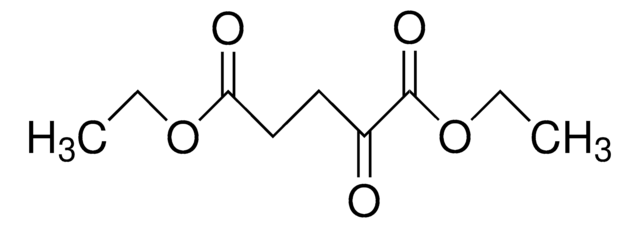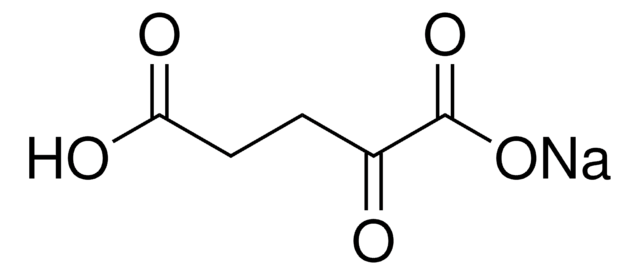If this product has an expiration or retest date, it will be shown on the Certificate of Analysis (COA, CofA). If there is no retest or expiration date listed on the product's COA, we do not have suitable stability data to determine a shelf life. For these products, the only date on the COA will be the release date; a retest, expiration, or use-by-date will not be displayed.
For all products, we recommend handling per defined conditions as printed in our product literature and website product descriptions. We recommend that products should be routinely inspected by customers to ensure they perform as expected.
For products without retest or expiration dates, our standard warranty of 1 year from the date of shipment is applicable.
For more information, please refer to the Product Dating Information document: https://www.sigmaaldrich.com/deepweb/assets/sigmaaldrich/marketing/global/documents/449/386/product-dating-information-mk.pdf
Kluczowe dokumenty
349631
Dimethyl 2-oxoglutarate
96%
Synonim(y):
Dimethyl α-ketoglutarate
Wybierz wielkość
497,00 zł
Wybierz wielkość
About This Item
497,00 zł
Polecane produkty
Poziom jakości
Próba
96%
Formularz
liquid
współczynnik refrakcji
n20/D 1.439 (lit.)
bp
90-95 °C/0.4 mmHg (lit.)
gęstość
1.203 g/mL at 25 °C (lit.)
grupa funkcyjna
ester
ketone
ciąg SMILES
COC(=O)CCC(=O)C(=O)OC
InChI
1S/C7H10O5/c1-11-6(9)4-3-5(8)7(10)12-2/h3-4H2,1-2H3
Klucz InChI
TXIXSLPEABAEHP-UHFFFAOYSA-N
Powiązane kategorie
Opis ogólny
Zastosowanie
Kod klasy składowania
10 - Combustible liquids
Klasa zagrożenia wodnego (WGK)
WGK 3
Temperatura zapłonu (°F)
Not applicable
Temperatura zapłonu (°C)
Not applicable
Środki ochrony indywidualnej
Eyeshields, Gloves
Wybierz jedną z najnowszych wersji:
Masz już ten produkt?
Dokumenty związane z niedawno zakupionymi produktami zostały zamieszczone w Bibliotece dokumentów.
Klienci oglądali również te produkty
Produkty
Sigma article discusses tumor cell metabolic pathways, focusing on aerobic glycolysis and mitochondrial activity.
-
How can I determine the shelf life / expiration / retest date of this product?
1 answer-
Helpful?
-
-
How is shipping temperature determined? And how is it related to the product storage temperature?
1 answer-
Products may be shipped at a different temperature than the recommended long-term storage temperature. If the product quality is sensitive to short-term exposure to conditions other than the recommended long-term storage, it will be shipped on wet or dry-ice. If the product quality is NOT affected by short-term exposure to conditions other than the recommended long-term storage, it will be shipped at ambient temperature. As shipping routes are configured for minimum transit times, shipping at ambient temperature helps control shipping costs for our customers. For more information, please refer to the Storage and Transport Conditions document: https://www.sigmaaldrich.com/deepweb/assets/sigmaaldrich/marketing/global/documents/316/622/storage-transport-conditions-mk.pdf
Helpful?
-
-
What is the recommended solvent for diluting product #349631-5g? Should it be diluted in DMSO, water, or a buffer such as PBS?
1 answer-
The recommended solvents for this chemical are DMSO at a concentration of 30 mg/ml, ethanol at 30 mg/ml, and PBS (pH 7.2) at 10 mg/ml.
Helpful?
-
-
Hello, What is the concentration of this product in its liquid form? I see the molecular weight, but not the total concentration. How many grams were dissolved in the amount of solvent present?
1 answer-
This product is supplied as a neat or pure liquid with a density of 1.203 g/mL and a molecular weight of 174.15 g/mol. The minimum purity is 96%, thus the molarity will vary slightly from lot to lot. The molarity can range from 6.63M (96%) to 6.9M (100%). The lot specific purity is reported on the Certificate of Analysis.
Molarity = density/MW * 1000 * concentration of the specific lot.
Helpful?
-
-
Dear support, what is the shelf life of this product?
1 answer-
This product is not assigned an expiration date or recommended retest date. Products with no expiration date or recommended retest date should be routinely inspected by customers to ensure they perform as expected. These products are also subject to a one year warranty from the date of shipment. For more information you may access the "Product Dating Information" document under "ADDITIONAL USEFUL DOCUMENTS ABOUT OUR PRODUCTS" at the bottom of the Quality Services page with this link: https://www.sigmaaldrich.com/life-science/quality-and-regulatory-management/quality-services.
Helpful?
-
-
Dear Support, At what temperature should it be stored?
1 answer-
This product should be stored in room temperature. Store the product tightly closed under dry conditions.
Helpful?
-
-
Dear Support, What solvent was used to dissolve Dimethyl oxoglutarate? Thank you!
1 answer-
Solubility testing is not performed on this product. According to various sources it is soluble in DMSO (30mg/mL), DMF (30 mg/mL), and Ethanol (30mg/mL). This information has not been validated.
Helpful?
-
-
What is dimethyl 2-oxoglutarate made up in?
1 answer-
This product is not diluted with any solvent. The physical form is a liquid. It is considered a 'neat' product with a minimum purity of 96%. The density is 1.203 g/mL at room temperature. The product is sold by weight, the 5 gram package would be approx. 4.16 mL.
Helpful?
-
-
Dear support desk, Is dimethyl 2-oxoglutarate cat #349631 sterile liquid? Thank you in advance
1 answer-
This product it is not sterile.
Helpful?
-
Active Filters
Nasz zespół naukowców ma doświadczenie we wszystkich obszarach badań, w tym w naukach przyrodniczych, materiałoznawstwie, syntezie chemicznej, chromatografii, analityce i wielu innych dziedzinach.
Skontaktuj się z zespołem ds. pomocy technicznej




![1,4-Diazabicyclo[2.2.2]octane ReagentPlus®, ≥99%](/deepweb/assets/sigmaaldrich/product/structures/366/129/a6ff4175-974d-4fac-9038-b35e508ef252/640/a6ff4175-974d-4fac-9038-b35e508ef252.png)






